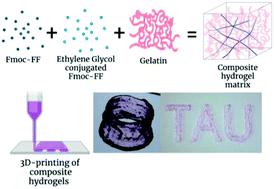Our official English website, www.x-mol.net, welcomes your feedback! (Note: you will need to create a separate account there.)
Stabilizing gelatin-based bioinks under physiological conditions by incorporation of ethylene-glycol-conjugated Fmoc-FF peptides
Nanoscale ( IF 6.7 ) Pub Date : 2022-06-01 , DOI: 10.1039/d1nr08206j Francesca Netti 1, 2, 3 , Moran Aviv 1, 2, 3, 4 , Yoav Dan 1, 2, 3 , Safra Rudnick-Glick 1, 2, 3 , Michal Halperin-Sternfeld 1, 2, 3 , Lihi Adler-Abramovich 1, 2, 3
Nanoscale ( IF 6.7 ) Pub Date : 2022-06-01 , DOI: 10.1039/d1nr08206j Francesca Netti 1, 2, 3 , Moran Aviv 1, 2, 3, 4 , Yoav Dan 1, 2, 3 , Safra Rudnick-Glick 1, 2, 3 , Michal Halperin-Sternfeld 1, 2, 3 , Lihi Adler-Abramovich 1, 2, 3
Affiliation

|
Over the last decade, three-dimensional (3D) printing technologies have attracted the interest of researchers due to the possibility of fabricating tissue- and organ-like structures with similarities to the organ of interest. One of the most widely used materials for the fabrication of bioinks is gelatin (Gel) due to its excellent biocompatibility properties. However, in order to fabricate stable scaffolds under physiological conditions, the most common approach is to use gelatin methacrylate (GelMA) that allows the crosslinking and therefore the stabilization of the hydrogel through UV crosslinking. The crosslinking process can be harmful to cells thus decreasing total cell viability. To overcome the need for post-printing crosslinking, a new approach of bioink formulation was studied, incorporating the Fluorenylmethoxycarbonyl diphenylalanine (Fmoc-FF) peptide into the Gel bioink. However, although Fmoc-FF possesses excellent mechanical properties, the lack of elasticity and viscosity makes it unsuitable for 3D-printing. Here, we demonstrate that covalent conjugation of two different ethylene glycol (EG) motifs to the Fmoc-FF peptide increases the hydrophilicity and elasticity properties, which are essential for 3D-printing. This new approach for bioink formulation avoids the need for any post-printing manufacturing processes, such as chemical or UV crosslinking.
中文翻译:

通过掺入乙二醇共轭 Fmoc-FF 肽在生理条件下稳定基于明胶的生物墨水
在过去的十年中,三维 (3D) 打印技术吸引了研究人员的兴趣,因为它可以制造与感兴趣的器官相似的组织和器官样结构。用于制造生物墨水的最广泛使用的材料之一是明胶 (Gel),因为它具有出色的生物相容性。然而,为了在生理条件下制造稳定的支架,最常见的方法是使用甲基丙烯酸明胶 (GelMA),它允许交联并因此通过紫外线交联稳定水凝胶。交联过程可能对细胞有害,从而降低总细胞活力。为了克服印刷后交联的需要,研究了一种新的生物墨水配方,将芴甲氧羰基二苯丙氨酸 (Fmoc-FF) 肽结合到凝胶生物墨水中。然而,尽管 Fmoc-FF 具有优异的机械性能,但缺乏弹性和粘性使其不适合 3D 打印。在这里,我们证明了两种不同的乙二醇 (EG) 基序与 Fmoc-FF 肽的共价共轭增加了亲水性和弹性特性,这对于 3D 打印至关重要。这种用于生物墨水配方的新方法避免了对任何印刷后制造工艺的需求,例如化学或紫外线交联。我们证明了两种不同的乙二醇 (EG) 基序与 Fmoc-FF 肽的共价共轭增加了亲水性和弹性特性,这对于 3D 打印至关重要。这种用于生物墨水配方的新方法避免了对任何印刷后制造工艺的需求,例如化学或紫外线交联。我们证明了两种不同的乙二醇 (EG) 基序与 Fmoc-FF 肽的共价共轭增加了亲水性和弹性特性,这对于 3D 打印至关重要。这种用于生物墨水配方的新方法避免了对任何印刷后制造工艺的需求,例如化学或紫外线交联。
更新日期:2022-06-06
中文翻译:

通过掺入乙二醇共轭 Fmoc-FF 肽在生理条件下稳定基于明胶的生物墨水
在过去的十年中,三维 (3D) 打印技术吸引了研究人员的兴趣,因为它可以制造与感兴趣的器官相似的组织和器官样结构。用于制造生物墨水的最广泛使用的材料之一是明胶 (Gel),因为它具有出色的生物相容性。然而,为了在生理条件下制造稳定的支架,最常见的方法是使用甲基丙烯酸明胶 (GelMA),它允许交联并因此通过紫外线交联稳定水凝胶。交联过程可能对细胞有害,从而降低总细胞活力。为了克服印刷后交联的需要,研究了一种新的生物墨水配方,将芴甲氧羰基二苯丙氨酸 (Fmoc-FF) 肽结合到凝胶生物墨水中。然而,尽管 Fmoc-FF 具有优异的机械性能,但缺乏弹性和粘性使其不适合 3D 打印。在这里,我们证明了两种不同的乙二醇 (EG) 基序与 Fmoc-FF 肽的共价共轭增加了亲水性和弹性特性,这对于 3D 打印至关重要。这种用于生物墨水配方的新方法避免了对任何印刷后制造工艺的需求,例如化学或紫外线交联。我们证明了两种不同的乙二醇 (EG) 基序与 Fmoc-FF 肽的共价共轭增加了亲水性和弹性特性,这对于 3D 打印至关重要。这种用于生物墨水配方的新方法避免了对任何印刷后制造工艺的需求,例如化学或紫外线交联。我们证明了两种不同的乙二醇 (EG) 基序与 Fmoc-FF 肽的共价共轭增加了亲水性和弹性特性,这对于 3D 打印至关重要。这种用于生物墨水配方的新方法避免了对任何印刷后制造工艺的需求,例如化学或紫外线交联。



























 京公网安备 11010802027423号
京公网安备 11010802027423号